back to main page
The macro photos (magnified images) in this section were captured with the Little BigShot Image Amplifier, which gives my little compact camera a good boost for closeups. Link to the product: Little BigShot.
Welcome to my zoomed-in world of insects! I tend to focus upon the imperceptible details and design features of these beings using the style of capture known as photomicrography (using the camera as a close-range microscope). The photos depict raw nature; meaning that the insects appear as they self-present in nature. I do not trap nor kill them in order to get the shot. And I do not enhance the photos with software, unless a minor brightness adjustment is required for internet visibility.
The Rhododendron Leaf Hopper, or as I'm known to call him: Bug of Many Colors, taking rest in his creamy green homeland.

Who could possibly guess that this long, spiky, prehistoric-looking insect is the larva of the round, smooth, shiny ladybug!

. . . speaking of the ladybug, here's one of those shiny creatures basking in the early morning sun.

This hoverfly is perched on a chicory petal, planning his assault on the pollen-laden stamens below. Look at the gold and brown tapestry of his abdomen!

This shiny, glittering, metallic green being is the cuckoo wasp.

The cucumber beetle with his nose diligently at the grindstone.

This is the handsome and charming Milkweed Beetle (not to be confused with the Milkweed Bug). They're so very curious about me and my camera, and come meandering up to me to see what I'm all about. They don't fear me a bit, so it's quite simple to capture them in all kinds of cute poses. And just look at him with his round red face and robust red body spotted in occasional black, and then of course, there are those longhorn antennae!



This guy was a little shy; observing me by peeking from between some Milkweed blossoms. Cute, ain't he?

This species devotes 50% of their time to sex; a trait we humans would do well to emulate.

It's all about getting the girl . . . isn't it.

This shiny, colorful fellow is called Dogbane Beetle, and his metallic mirrored wings reflect his surroundings, causing him to appear to change color while on the move.

Now here's something amazing. I got lucky and caught him spreading to fly. Not a great photo, but you can clearly see that his lower wings are a silver or aluminum color and his body is also silvery metallic. Is this not a strange and wondrous creature!

In this photo, you can see a reflection of ME! One arm is extended to block direct sunlight from overexposing the scene. Can you see me?

And one more shot of this beautiful animal before we move on.

Red Admiral Butterfly on Milkweed Blossoms.

Underside view of his tapestry wings.

Another gorgeous and gallant pose.

I included this image because you can see his nectar sucking tube extended and inserted into the gland of the blossom. This is, after all, why they come to the Milkweed plant . . . to feast!

Here's a mystery which baffled me. In this photo, the animal is displaying the underside of his wings and as usual, the blue and red can be seen. In the next photo, watch what happens . . .

Same animal, same pose, but he had flown to a new plant a few feet from me. For some reason, the blues and reds seem to have vanished. It must have been the angle of the sun. Isn't that curious!

Some animals find the prettiest places to weather a storm.

A few shots of the Mourning Cloak butterfly.



All snug like a bug in a rug . . . or Russian-Olive leaf.

He's just a dim little beetle with a few orange veins in his otherwise dull grey wings . . . or . . . is he?
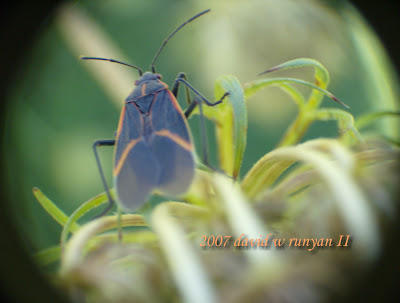
I just happened to pull the trigger at the precise moment when he was spreading to fly! And so now we see that his dull wings conceal a most amazing ruby-red bug body!

This stout little insect (1/4"), has a prehistoric, reptilian look about him. Notice the thick, scaly shield over the eye, and the crocodilian tail. However, their tails are equipped with cottony fibers; a characteristic not shared with crocodiles lol. Nothing at all cottony soft about a croc. And his eyes are amber with brown swirls and a red dot in the center. A peculiar and intriguing species this is.

Ants are so active, it's hard to focus, so I tried a new technique and was rewarded with this very sharp, clear, detailed photomicrograph of a black ant, who paused briefly to stabilize some food or material into his mouth.

This little insect caught my eye because of the orange markings on his predominantly black body. Here he is at 10x. But the closer I got, the more details I could see and it turns out that the little fella is a fascinating design. This is actually the larva stage of a very common flying insect. Can you guess which?

At 20x, we begin to see that he has a ridge running down his thorax and abdomen that looks like a spine, and we see that on all 3 sections of his body, he's covered with spikes.

At 40x, all these features come into much finer focus.

At 60x, we see that his thorax and abdomen spikes are forked. His design looks quite ancient, prehistoric even, well armored. Also notice how nicely this level of magnification brings out the fine hairs of the leaf. And to answer the matter . . . this is the larva of what will eventually become . . . the ladybug beetle!

The Tractor-Trailer Spider
This very handsome spider darts around so quickly that it's difficult to see what he's all about, but you can tell that he has some attractive markings. And he's tiny, which adds difficulty to observing him. His constant rapid movements make photomicrographs nearly impossible. I snapped over 20 images and have a total of only two in focus. I call him the TractorTrailer Spider because his abdomen pivots and when he turns, the abdomen follows his thorax in much the way a trailer follows a truck around a corner.

To the naked eye, he appears to be black and silver. The photomicrograph reveals off-white and brown in the mix of his stripes. He is downright handsome, and no one could claim otherwise with any credibility.

Is there any color not represented on this beetle? Apart from the obvious yellow, orange and green of his body, I see purple eyes, and pale hues of blue on his legs. It wouldn't all surprise me if his bottom had red. His common name is Four Lined Plant Bug, and his scientific name is Poecilocapsus lineatus.

Dragonflies are, of course, enchanting. But this fellow is remarkable. The cyan and lavender globules on his head are his eyes. And dependent upon the angle of his eyes to the sun, the cyan and lavender migrate and change hue.

zooming in a bit on Mr. CyanEyes, from this angle, we see that there is a significant red tint in his left eye.

from this angle however, both eyes are predominantly cyan.

This handsome little spider has bold symmetrical black spots lining the edges of his beige abdomen. You will notice that his dark spots are circled in off-white. His abdomen bears a margin down the center, and on either side of the margin are dimples, which are his breathing passages, his nostrils as it were.

As we zoom in tighter, his top row of 4 black eyes come into sharp focus.

He was such a small thing that I wasn't able to fill the frame with his spider body. Small yet full of design wonder.

A few days ago, in a certain forest, I found an empty cicada exoskeleton. Photos of that find appear a few entries down, amidst the magnified raindrops. I was in the same forest today and came across live cicadas in the process of emerging from their exoskeletons! Though it was raining hard, making photography very difficult, I managed a few shorts which convey the amazing event.
Here's our cicada, after having wrapped his old legs around the tree twig to secure his old body, he then kicks and claws his way out of his crawling insect body to become a flying insect. The more-or-less triangular mass on the side of his thorax is his wing, which is rolled up for protection during the extrication process.

When the clever fellow is finally free of his past, he then clings to his past and dangles from it, which permits gravity to begin unrolling his new wings. And who says one should not cling to their past!

And here we see his wings completely unfolded and taking shape. When I met him, he was perhaps 50% extricated and the remainder of the process took an hour. So for about 2 hours, cicadas are helplessly exposed to birds and other predators, color-conspicuously so. It was an amazing sight to see . . . glad I was present.

People often ask me how I manage to find all these wonders. They ask if I have exceptional eyesight. Fact is, I have poor eyesight and i hike without my glasses because i feel more natural that way. I explain it like this: as I walk, my mind develops an expectation based upon current sensory perceptions and when there is some anomaly; be that color, movement, sound or some other aspect of the scene which doesn't fit the expectation, I am drawn to it.
In this instance, one petal of the daisy was folded over, and that anomaly drew me to the wildflower. However, what I found upon arrival was spectacular! What you don't see by virtue of the lens limitation, is the male spider intermittently peeking thru the petals of the daisy. Each time the female spotted him, she struck this "open arms" pose; lifting herself toward him. And the courtship cycle occurred 8-10 times to my knowledge.

She then slowly and somewhat cautiously made her way toward him, and eventually slipped between the petals herself, to the back side of the wildflower where her lover awaited.

And here we see his brown legs wrapped around her. I then left the lovers in peace. This event made my day. Nature never fails to surprise and delight. I can't say that I've ever had a day when a trip into the wilds yielded zero wonders . . . and I explore nature almost daily . . . have for decades.

While my sunset or waterfall images may appeal aesthetically to the viewer, from a photomicrographic perspective, this picture represents a triumph of skill and technique. I was able to overcome wind, insect motion, and hand jitters to obtain a very clear and detailed micrograph of the White Faced Hornet.

Stunningly handsome he is, and also usually eager to sting we the people lol.

I call this wondrous creature Spider-in-a-Seashell. His actual common name is Spined Micrathena.
He is amazing in several ways. His abdomen appears to outweigh the rest of him at a ratio of about 10:1. Given this disproportion, one would assume him slow and ungainly on his web, but he is just as adroit as any other web arachnid. The60X micrograph shows that the silk he spins from a spout on his back is held and guided by one of his rear legs while with the other rear leg, he rapells along a parallel strand of prespun silk. In this way, he acts like his own pulley system; redistributing his weight along the length of the strands.

and he is just as fascinating from below.

60X micrograph

I met this handsomely patterned insect today, who was frolicking vivaciously on a Queen Anne Lace. At first, I thought he was a fly-type insect, but the micrographs revealed that he's a beetle, with hard outer wings. Strikingly handsome with his cocoa base and cream spots. And his body has the texture of suede. There is a softness to him which I've not seen on other beetles.

A closer look. One of the remarkable aspects of this creature is that he glistens in the sun, and this attribute is not detectable to the naked human eye. Another advantage of photomicrography. :)

This is the best shot of his eye.

His head was always down. No surprise. Like all insects, he was designed to pollinate plants by curiously exploring them and then to mate; thereby insuring the perennial continuance both of plant and insect.

The Grand and Glorious Monarch Butterfly
I happened to find a meadow this autumn wherein migrating Monarchs were feeding and resting for about 10 days, and was able to capture several excellent telephoto shots of them in their many splendid poses.









My original intention here was to shoot Snakeroot wildflower. I spotted a robust plant, and as I approached, I noticed that it was playing host to a young female crab spider, so it became a two-for-one photo opp. This is a stringy little flower with tiny white corollas. It also happens to be a poisonous plant, but since spiders are insectivores, I don't suppose she's in any danger. A little cutie she is with her patterned back and banded legs.

Spider personalities differ. Some are shy and some are less shy, but if you make slow, gradual movements, then you can usually get the camera within 2 inches, as was the case here. She stayed put for a series of shots; afterwhich I withdrew and left her in peace.

Normally at these magnifications I can capture their multiple eyes, but she's a baby and her eyes are just too tiny yet.

I often wonder about the design of spiders, and especially those who stalk prey on flowers. You would think they'd rely upon camouflage, yet, in every case, their backs are conspicously painted by nature in vibrant contrasting colors and in stark artistic patterns which don't blend in with wildflowers at all. Anyway, isn't she a fascination?

Here's a predominantly black spider with white translucent legs covered in orderly spikes of hair and tipped in black, and look at his mandibles! They're clubbed, and look like a pair of boxing gloves. This is worth enlarging (click on the photo).

I have no clue what he is, but isn't he exotic looking! His rear legs and antennae seem inordinately long, his body (upon enlargement) is seen as a green on green contrast bounded by both vertical and horizontal lines, and his tail presents a most curious set of thorns! This is altogether, a bewildering design.

I spotted this grasshopper on a stem, and since I could only see the top half of his rear hopping legs, I thought perhaps he had been injured.

So, I used more magnification and could see that the lower part of his leg was simply tucked up under the upper half. whew! Perhaps this is their habit while resting. Anyway, if you enlarge this, (click on the pic) you'll see that this came up clean and crisp; providing excellent detail on his eyes and his exoskeleton.

A little girl, perhaps 4 years old, as I passed by, called out to me in excitement over a caterpillar she found. So I went to view her find, and what a find it was! No wonder she was excited. This little caterpillar is quite ornate and colorful with peculiar design features, most notably his antennae, which are so wide, they look like legs. And they extend from the side of the head as opposed to the usual fine filaments which extend from the front of most insect faces.

Upon closer examination, we find that his antennae are actually bundles of filaments. We also notice the nodular collars of his yellow bands.

From this angle, we see that he has predominantly white shiny hairs and also black hairs which are less frequent but significantly longer. His orange head is coordinated with two orange spots on his tail section, and he has four yellow and white plumes of tufted fur. It was hard to tell whether the little girl or the adult photographer was more excited. Either way, a spectacular insect was enjoyed by both.

The Eastern Tiger Swallowtail, posing gallantly atop the velvet crown of a bull thistle in Chicago, IL.
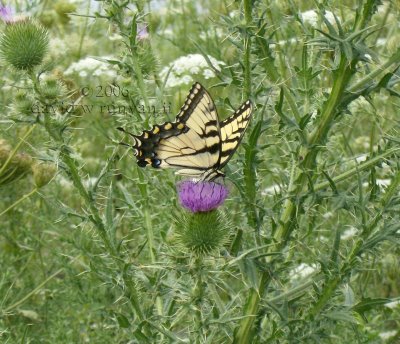
And he posed so cooperatively for me, wings fully extended, displaying his design grandeur.

The same species, 600 miles to the east, in Pittsburgh, PA, atop a teasel thistle. The distinctions are subtle; detectable only through attention to fine details.
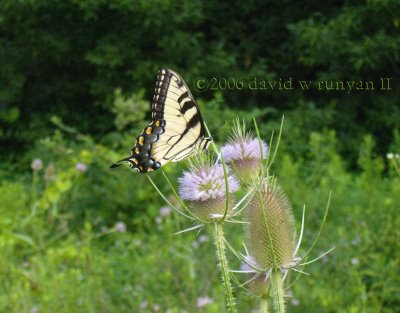
Whether in flight or at rest, this is a gloriously attractive insect.

This Red Admiral enjoyed sharing the meadow with the monarch butterflies. Notice his golden-tipped antennae and the 4 blue spots at the end of his aft wings.

This deep brown butterfly is a swallow tail of some type, and it appears that he may have escaped being eaten. The swallow tip is missing from his left wing and there is a gap to the left of where the swallow tip would have been.

Mourning Cloak Butterfly
This exquisite fellow has burgundy wings, decorated in blue spots, and lined in beige. Also, the leading edge of his forewings have a sparkling stripe of white beads. And he posed for me on a white birch. The common name for this butterfly is Mourning Cloak. He was the only insect encountered today; causing me to wonder about him . . . did he lose his way? Since there are no wildflowers left at all, what will he eat? He was a mystery in many ways, but thrilling to find in the cold New England Autumn.

And here's the hoverfly, his abdomen painted with all the artistry of Aztec tapestry. A thinking person might conclude that Aztec tapestries derived their design concepts from the hoverfly, and not from original thought processes. It could well be that all visual art is rank plagiarism of that which is found in nature; albeit, at times, distorted to conceal the lack of originality.

A pair of hoverflies prancing on a cinquefoil. Enlarge this photo. You can actually see the fly on the left clasping a stamen with his front legs and tugging on it.

Hoverfly on Snakeroot plant.

This shot reveals that his eyes, which seem to comprise 90% of his head, have flats on both the top and inside edges.

In this shot from last year, the hoverfly pollinates a chickoree plant.

This is the exoskeleton of the cicada. When they depart their bodies, they leave behind a highly intact shell; including their eye lenses, which is the subject of the next photo.

At 30x, we see that the eye lens is clear; to the extent that the antenna can be seen through the lens. Also notice the curious flat spot on the surface.

This is a common house fly in the Chicago area, where I am presently visiting. The term "common" refers only to his abundance since when we examine him closely, we find amazing design features which are anything but "common".
A tiny insect, perhaps 1/8" long with a wingspan of 1/4".
His head is covered in woolly fir. I would go as far as to say he has more hair than i do. And you will notice two tufts of silver hair curling back toward his wings. His antennae are minutely ornate; resembling a stem of ferns at spaced intervals. His wings are lined with fringe and the leading edges of his wings have tufts of fur. The most amazing visual aspect of him are the wing edges, outlined in black and having bright white spots at regular intervals, much like the running lights on a semi trailer.
You might also notice how the bright white spots bleed down onto the fringe; giving the appearance of bio-luminance.
Abundant might his species be, but not a one of them is "common". They are design masterpieces.

This is that tiny insect with the mint-green wings that have the look and texture of leaves. Quite an attractive one he is with his pale green and deeper green veins, lime green legs and face and white eyes with a brown dot in the center. It's a dark rainy day and the camera is having trouble delivering a clear photo. If the rain stops, I will try again.

I spotted a web today, and could see a silhouette of an insect within. I thought it might be a funnel web spider.

So I blew a little wind toward the web and the insect moved. A few minutes passed and then he began showing himself at the aperture of the web, but he was darting rapidly. I waited patiently for several minutes and this was the best photo I could obtain. He was a small fellow, 1/4" or thereabouts. The sun in front of the camera did wonders for illuminating the translucent amber sections of his legs and mandibles, but did little to shed light upon his spider face. But if you look closely, he appears to have only two eyes which are spaced far apart for a spider. Can you see them? Try enlarging the photo by clicking on it, then use your BACK button to return.

The fragile and timid Daddy Longlegs. These creatures fascinate me for a variety of reasons. But I was thinking tonight how though I have seen perhaps thousands of them within my lifetime, I have never seen them hunt and eat. Yet their prevalence is a testimony to their skills as hunters. Also, consider that unlike spiders which have distinct head/thorax and abdomens, this insect seems to combine all 3 bodily sections into one simplistic unit. And when you observe their legs, so long and close together, one would expect them to be stumbling over their own feet and yet they are swift and nimble. So much instinctive intelligence in such a seemingly simplistic organism.

Here is one of those handsome but shy, brown spiders, posing outstretched on goldenrod.

Many spider species have 8 eyes, but on this guy, they are easily detectable as a top row of 4 larger eyes and a bottom row of 4 smaller eyes. Also, you can notice 2 dimples on his abdomen (back). All spiders have these; these are their breathing passages (nostrils).

60X, and the lens was less than a half inch from him for this shot. There are at least 2 fascinating aspects to this view; first, you can see that one of his eyes has fur draped over it, secondly, in one eye on the top row, if you zoom in, you can see the reflection of the sun in his eyeball.

I call him the Bug of Many Colors . . . just look at him! This tiny insect is loaded with design and color; cyan, red, yellow and orange, and when we zoom in a bit, we find deep purple margins at the trailing edge of his wings.

At 60X, we see that his head is pale yellow with powder blue eyes, and his thorax bears a triangular orange wedge. This little guy is simply put; endlessly enchanting.

From the side, we see that his outer wings have a trailing purple margin, and a peculiar, stinger-like protrusion of white in an orange sheath.

In this particular shot, it becomes apparent that in addition to his outer wings having a purple margin, his inner wings are also purple, and the same shade. His badomen suddenly transitions cleanly from yellow to orange. All told, a surprising entomological entity.

An extremely small grasshopper-like insect with wings in camouflage design like you see on military hardware lol.

This is a nearly microscopic spider. To give you a frame of reference, the spider is crawling along mortar between two bricks. The mortar is about 1/4" thick and about half of it is showing, so about 1/8" or 125 mils. The spider along his longest dimension, is about 1/7th the thickness of the mortar or 18 mils. One strand of human hair is 5 mils, so the spider is only as long as 3.5 human hairs lying side by side and intimate. Magnification is a wondrous thing.

This iridescent green fly seems to glow while in flight.

The beloved honey bee.

Until this shot, I was completely unaware of the cut and flair of the bumble bee wings!

His rust-red eyes very nicely coordinate with his silver body with woven texture.

Here's a flying insect species I've not met before; a first-time find, which always thrills. Basically, he has a dark chocolate head and thorax, then a white abdomen beneath clear wings with golden edging. His legs are alternately banded in brown and yellow. His eyes are enormous; occupying about 75% of his head, and from between his eyes emerges a pointed beak from which his antennae extend sidewards. His tail section sports 4 dark spots. He seems to favor the daisy, hopping from one to the next, and never to a different wildflower. I spent the majority of my time today following him from daisy to daisy. All of these photos are best viewed by enlarging (click on the photo) since his dark pigmentation conceals details. This is the best shot of his magnificent eyes.

This is the best shot of his two-tone banded legs, the dark spots on his tail, and the golden margin of his narrow wings over his broad white abdomen.

This photo nicely displays the relationship between his abdomen and wings, and we also notice knots on his thorax.

Well isn't this the shiniest little fly with his emerald green and copper colors, iridescent wings and segmented abdomen!

This little guy just looked so conspicuous perched atop this plant in plain view of all the hungry birds.

Here he is at 60x

You can see his outer wings beginning to separate. I was of course hoping for another beetle-in-flight photo , but alas . . . it was not to be.

. . . even so, isn't he attractive perched atop this daisy?

This is the wood tick. The wood tick does not carry lyme disease. The deer tick carries the disease. The deer tick has a bright red abdomen, and as you can see, the wood tick is completely brown, so it isn't possible to mistake the two. Wood ticks can not harm you. Additionally, wood ticks are the more common of the two; representing 85% of all ticks in forests. There is no need to forgo hiking in fear of ticks. Wear shorts, tape the top of your socks, the bottoms of your shorts, and check the inside of your shoes and your hair before getting into the car. Even if ticks dig in, you have 72-96 hours to remove them before an infected deer tick could cause you any harm. People truly overreact to these parasitic arachnids, and the fear is totally unfounded. A public service announcement from Mr. David.

For example, here's a Wood Tick, making haste up my sock, which is precisely why I wear white socks and tuck my jeans into my socks while hiking. Ticks first cling to your shoes or ankles and make their way up your body in search of your hair, so if you wear long white socks, you can spot them easily and remove them long before they reach your head.

My son Mark and I spent about an hour with this praying mantis and made numerous observations pertinent to his behaviors and presentations. He mesmerized us for a number of reasons, many of which were not related to his appearance; although on the scale of design curiosity, he ranks high.
He is an engaging insect. What I mean by this is that he acknowledges humans to a more personal degree than do other insects, and he interacts with them according to this recognition. He possesses personality; seeming more like an animal than an insect.
At one point, Mark played with him using a small twig, inciting him to follow the twig with his eyes, showing us his uncanny head-rotational capabilities, and he lunged at the twig after analyzing the best time to strike . . . much as would a kitten with a piece of string. And he did this repeatedly. When Mark raised the twig above him, he stood on his hind legs and reached up toward it as would a dog to reach a bone held overhead.

This is my favorite photo! His pose makes it look as though he's conducting an orchestra in a tuxedo with tails .



He was not the stereotypical motionless mantis, awaiting his prey. He was interactive and active, always on the move, and when I tried to get 60X micrographs of his head and face, he invariably attacked the camera, causing motion blur lol. But I did manage to get this solitary micrograph.

Just look at this guy! His colors, patterns and shapes are all very stunning; most of all his wings, which are translucent with lean swept white stripes and wider tan swirls! As if this wasn't adequate artistry, he is endowed with yellow spurs curling into his amber thorax, and he has a mahogany beer barrel abdomen.

Here's another visually intriguing insect which is similar in some ways with the previous insect. His wings have caramel and white stripes so I call him TigerWings. His head and thorax are shades of brown which match his wing stripes, but his abdomen transitions cleanly to black.

In this photo we can see that his eyes are large and that his head and thorax have stripes which are perpendicular to each other. I desired more photos, but he didn't linger. A first time species find.

This large beetle, more or less the size of a quarter, has unusual patterns and colors. Despite my gradual movements, he detected my presence and was on the move constantly. I managed a few reasonable shots before he crawled to concealment.

From this angle, I noticed that his legs are two-tone, so I named him Boots.

First time in my life to observe this species; such events never fail to excite.

Look at this fellow! A translucent green, wingless bug with red eyes, and markings on the top side of his abdomen in the visage of a human spine . . . so I call him Backbone.

This photo nicely presents his painted spine.

This photo clearly reveals his strangely elongated head and his strangely short thorax. another first-time species find . . . as bob dylan once sang (attempted to at least) . . . can't help it if i'm lucky . . .

This large spider sports 7 colors as well as stripes and a zigzag pattern on her abdomen. She put on a good show, catching and consuming a small insect while I observed. It was fast action. She did not wrap her prey . . . she simply devoured it.

from this angle, we see her abdominal zigzags. She is the same size as the black and yellow garden spider; body being 2" and legspan being 5" or thereabouts.

the dark lines are her lower jaw and the two members curving down toward her jaw are her mandibles. Yet another first time species find. I was on a roll today.

This is the largest hive I've ever found. It measures about 14 inches in diameter by 20 inches in length, and my guess is that its capacity is thousands of bees. No activity around the hive in today's 55 degrees, so i was able to examine it closely.

Spring Azure Moth - this species appears pale blue in flight, and notice please how nicely sunlight glistens upon his wing fringe.

A medium sized furry brown web arachnid; body an inch or so and legspan 3" or thereabouts.

In this shot, we see that his silk gland is a series of 5 cylinders, working in unison to produce a single strand of silk.

This mostly red fellow has brown eyes and small red spots at the tips of his translucent wings which is typical to most dragonflies . . . but, do you notice the red spots at the juncture where his wings sprout from his body? This marking is quite uncommon.

The Common White Darner or so he is named. But to me, his wings are mesmerizing. He has the typical dragonfly wingtip spots, but his rootbeer curtain colorings reveal the intricacy of the webwork of the wings; whereas the white regions conceal the web and present a creamy, cloudy texture which then extends into the transparent regions. Overall, a captivating visual design . . . I think.

Surprisingly, he permitted me to draw very close for this 60X micrograph, which dramatizes just how much of his head those bulging eyes do occupy. It also shows an aspect of the dragonfly which escaped me until I viewed this pic. Like most insects, dragonflies have antennae . . . but I had never before noticed. This shot explains why . . . they are quite short and threadlike.

This fellow's tail and legs look as though he dipped himself in a can of silver paint.
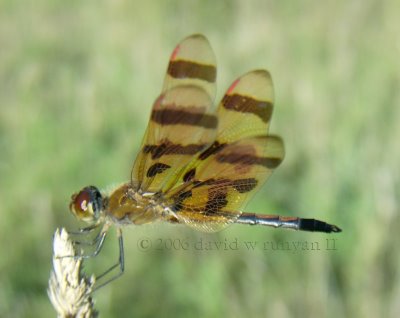
The day was constantly windy, a moderate wind of perhaps 10mph, but enough to make photography of dragonflies impossible. I did manage to snap a couple of fairly reasonable shots of this species, having a brown and yellow body with clear wings which shine in flight as when sun strikes a mirrored surface.


Consider this small damselfly. How do I know he's a damselfly as opposed to a dragonfly? One telltale sign is wings at rest. Damselflies fold their wings along their bodies while at rest; dragonflies rest with wings outstretched, perpendicular to their bodies. Another distinction is the eyes. Damselfly eyes are circular drums extending to the sides of the head, whereas dragonfly eyes are globular, wrapping around from the sides to the front. Hence, he is lock, stock and barrel . . . a damselfly.
Upon close examination, we find that he has clear wings and legs, his thorax is tan and brown with white stripes, his elongated abdomen has the coloration and joints to perfectly resemble a bamboo shoot, and his eyes are beige with light brown zig zag patterns. He's wonderfully designed, but in order to perceive it all, magnification is required.

At 60x, the design of the eyes becomes apparent; 4 brown zig zags cross the beige eye and a small dark spot can be noticed. If you're tempted to assume that the dark spot is his eye, you would assume incorrectly. His eyes are compound, made up of about 30,000 sensors. The entire drum-shaped section is eyeball. To better appreciate him, enlarge this shot by clicking on the photo.

It was so amusing to watch this male and female perform their endless aerial flirtations.They kept me entertained for about an hour before they left the sphere of sensuality for a more distant location.

I chanced upon this cherry-red Ladybug.

I like this shot because the insect is tilting its head. Not often you catch a Ladybug with head pivoted from the thorax. Almost gives him personality!

They shine like a cherished Corvette, hand waxed for hours on a sunny summer Saturday.

. . . and a closer look . . . much closer in fact.

This was an amazing sight. This ladybug elected to die in September or October by clinging to this teasel, and when I found her some 4 months later in January, her carcass was held in place by only one of her legs, and her body was swaying about in the wind.

I noticed this tiny green bug (1/16") crawling on my shirt, so I paused a while to observe his ways at maximum magnification: 90x.
Here he is, striding over the cotton horizon like the gallant explorer he is. Adorable little guy, wouldn't you agree?

From this angle, we clearly see that his red eyes cover quite a bit of the sides of his head. His legs end in dark tips and his antennae are banded in various shades of brown, which are attributes he shares with many insects.

Though at first glance, he seems like a simple, non-flying, unicolor insect, we can see here that he is endowed with embossed geometric patterns. Also, to look at him, it seems as tough he has no distinct head, thorax and abdomen, just a single body into which all 3 are blended. In any event, he was a delightful visitor.

i do hope to come across this caterpillar species again because i am not fully satisfied with this micrograph. however, it does show that the funnel-like features seen embedded into the insect's translucent eyes are the lenses of his compound eyes. magnification is a wondrous thing.

I call him Mr. CrabLegs for obvious reasons.

Mr. CrabLegs from a different angle.

and yet another angle, wherein he looks alot like a rhino.

Just your average, every-day, mostly brown, flying insect . . . who is so commonplace, that this was the first one I've seen in my 50 years on the planet.

This is the insect named the True Milkweed Bug. He has no fear of humans, and in fact seems rather curious. This round-faced guy came up over the leaf horizon to investigate my presence and purpose.

. . . and, he got lucky a bit later.

Nature is just so accommodating! This is a Queen Anne Lace plant in passed phase. When in bloom, it's a flat disk, and then becomes a tightly curled cup, inside which this caterpillar has found a relatively safe place to live.

The common Garden Spider. Completely innocuous, but does he not look fierce? This one is mature; his body being 2" and his legspan being 5"
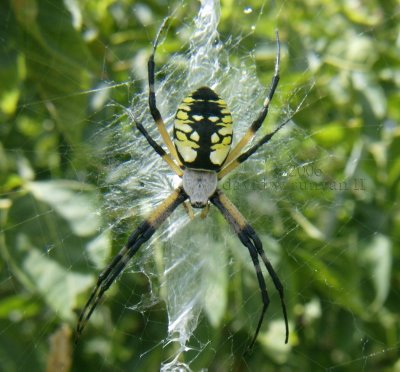
Meet the Northern Bluet Damselfly; that slender cylinder of floating, glowing neon blue. He does not bioluminesce, but while in flight, with sunlight upon his body, he appears to be steadily glowing. Not a rapid darter like the dragonfly, he tends more to be a fluttering hoverer, slow and graceful, but should you attempt to catch him in your hand, you then discover his capacity for velocity and evasiveness.
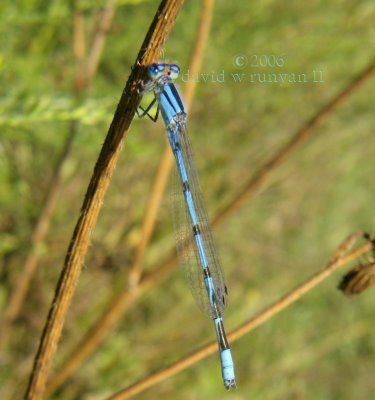
Of his many stunning features, his large eyes swirling in black and shades of blue are perhaps the most enchanting.

Pearl Crescent Moth.
So colorful, that in flight, he appears to be a small butterfly. And his antennae are eye-catching, band striped to coordinate with his primary colors, and tipped in narrow teardop shape in golden orange to match his wing spots.
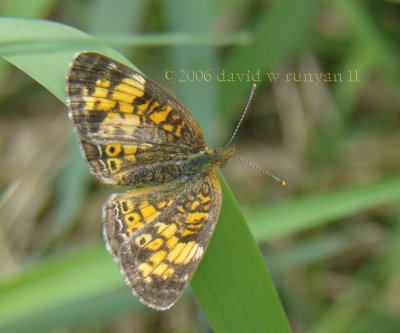
Pearl Crescents mating.

This tiny leaf spider is a study in contrasts; specifically the contrast between camouflage and conspciousness, for whereas his head and legs are perfectly blended into the leaf, his very artistic, geometrically patterned back calls attention to him from several yards away. His markings are both curious and beautiful.
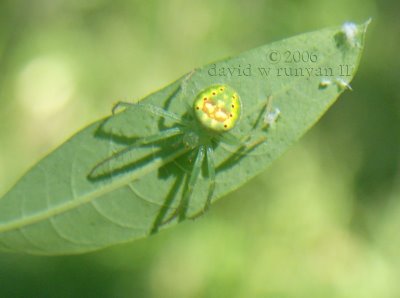
My finest yellow jacket shot of the season (or of any season for that matter LOL) and what a handsome and robust specimen he is, nuzzling a Queen Anne Lace!
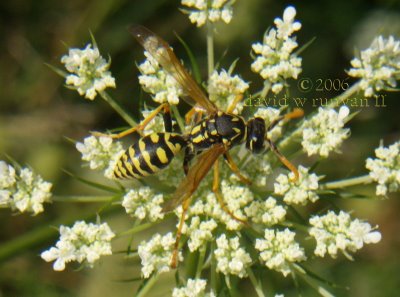
What a phenomenal bundle of colors and fibers!
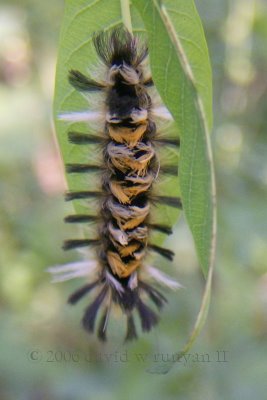 another of his species found the following year.
another of his species found the following year.
In this photo, his tiny suction cup feet can be seen.
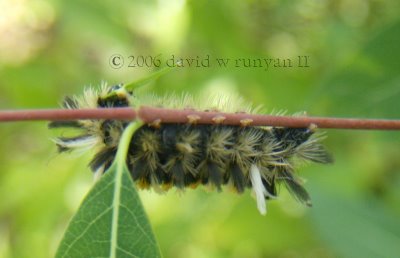
A pin striped suit, and a yellow carnation . . . I'm all dressed up for the dance . . . (borrowed from marty robbins, 1956, a white sport coat and a pink carnation)
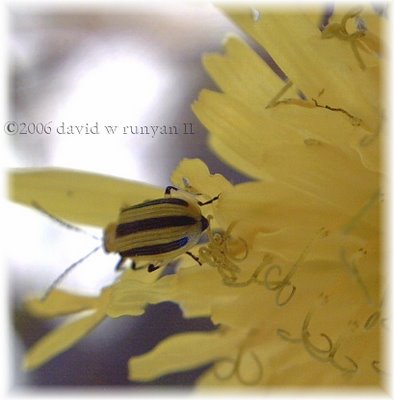
The amazing thing about this insect is the math. I discovered him by peeling back the bracts in an effort to examine the plant, and was surprised to find the caterpillar inside. I found an identical insect inside another plant of the same type. So I became curious of course and peeled back perhaps 20 plants and in each case, there was one caterpillar residing in the core. Never more than one and never none. I found this to be a highly curious equation indeed.

Despite his innocuous nature, this spider is simply ugly, and no one would be inclinded to cuddle with him. The 4 dimples on his back are the breathing passages common to all arachnids, but which happen to be highly noticeable on this particular species.
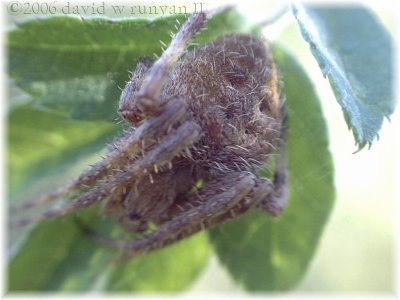
I really should be shot for invading such private moments of insect intimacy!

This is one of many insects which favor the milkweed plant. This particular insect has no wings, but for some reason, has been granted illusionary wings.

I don't suppose his parents have yet taught him how to blend in with his surroundings.

This is a laterally spun spider web, upon which the setting sun cast a silken rainbow. The photo quality is poor because I attempted to employ the wide angle micrograph lens (yes, such a thing exists). Next time I encounter this type of sight, I will use the telephoto, which has a better focal depth range.

Optical magnification is a wonderful thing. I've been acquainted with inch worms my entire life and though i realized they had horn-like appendages, I never knew they were as ornate as they are; the front horns make two complete twists before terminating in a straight prong.
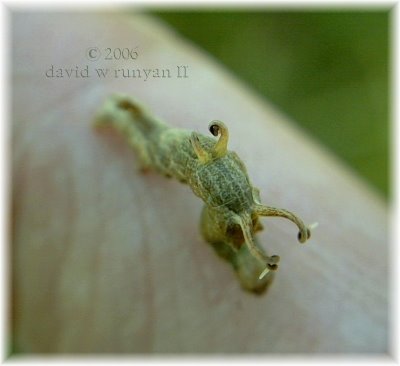
This beetle is the most common insect of any type in Chicagoland (excluding mosquitoes), and one can understand why quite easily since they are more often found mating than solo.


We always called these "inch worms" but they're obviously caterpillars.

This colorful moth is large; comparable to a mature monarch butterfly, and its wings are glossy, waxy.

Could he have possibly struck a more perfect pose?

What I find most striking about the Daddy Long Legs spider is that the frailty of his legs adequately supports his body, but if we were to calculate body mass vs. leg tensile strength over the cumulative distance of the 8 legs, we would find that our Creator was an engineer.


Life in the wilds is oftentimes unkind. This poor fellow is missing 3 of his 8 legs, yet seems to have adjusted to his handicap.

Identical to the Bluet except in coloration; most notably his solid green eyes as contrasted to the two-tone marbled design of the Bluet.

This is the ektoskeleton of the cicada; that locust-like insect which makes the loud humming/buzzing sound in trees. At midway through its life cycle, it clings to a stem or twig and sheds its skin, leaving this very detailed, intact skeleton behind.
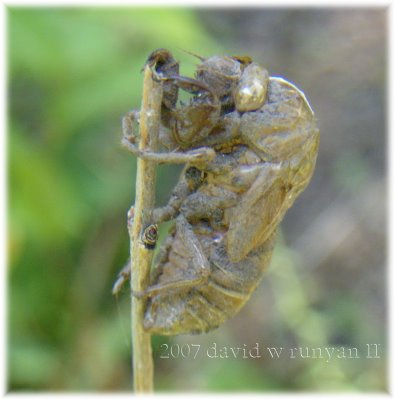
The cicadas marching up a tree prior to shedding their exoskeleton. No wings yet.

The periodic cicada as an uber-terranian adult. Quite the metamorphosis, wouldn't you agree?

Beauty and the Beast. The ugly common fly upon the beautiful furry blossoms of a Sumac tree.

This little spider has such nice cranberry colored regions.

back to main page
2 comments:
Your photos are absolutely beautiful!
I was truly captivated by your photos. They're a real eye opener to how many miracles God has created.
Post a Comment